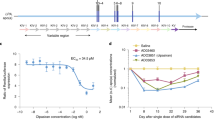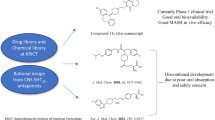Abstract
At present there are no drugs for the treatment of chronic liver fibrosis that have been approved by the Food and Drug Administration of the United States. Telmisartan, a small-molecule antihypertensive drug, displays antifibrotic activity, but its clinical use is limited because it causes systemic hypotension. Here, we report the scalable and convergent synthesis of macromolecular telmisartan prodrugs optimized for preferential release in diseased liver tissue. We have optimized the release of active telmisartan in fibrotic liver to be depot-like (that is, a constant therapeutic concentration) through the molecular design of telmisartan brush-arm star polymers, and show that these lead to improved efficacy and to the avoidance of dose-limiting hypotension in both metabolically and chemically induced mouse models of hepatic fibrosis, as determined by histopathology, enzyme levels in the liver, intact-tissue protein markers, hepatocyte necrosis protection and gene-expression analyses. In rats and dogs, the prodrugs are retained long term in liver tissue, and have a well-tolerated safety profile. Our findings support the further development of telmisartan prodrugs that enable infrequent dosing in the treatment of liver fibrosis.
This is a preview of subscription content, access via your institution
Access options
Access Nature and 54 other Nature Portfolio journals
Get Nature+, our best-value online-access subscription
$29.99 / 30 days
cancel any time
Subscribe to this journal
Receive 12 digital issues and online access to articles
$99.00 per year
only $8.25 per issue
Buy this article
- Purchase on Springer Link
- Instant access to full article PDF
Prices may be subject to local taxes which are calculated during checkout






Similar content being viewed by others
Change history
03 September 2018
In the version of this Article originally published, the author Peter Blume-Jensen was not denoted as a corresponding author; this has now been amended and the author’s email address has been added. The ‘Correspondence and requests for materials’ statement was similarly affected and has now been updated with the author’s initials ‘P.B-J.’
References
Mokdad, A. A. et al. Liver cirrhosis mortality in 187 countries between 1980 and 2010: a systematic analysis. BMC Medicine 12, 145 (2014).
Friedman, S. L., Sheppard, D., Duffield, J. S. & Violette, S. Therapy for fibrotic diseases: nearing the starting line. Sci. Transl. Med. 5, 167sr161 (2013).
Fleming, K. M., Aithal, G. P., Card, T. R. & West, J. All-cause mortality in people with cirrhosis compared with the general population: a population-based cohort study. Liver Int. 32, 79–84 (2012).
Trautwein, C., Friedman, S. L., Schuppan, D. & Pinzani, M. Hepatic fibrosis: concept to treatment. J. Hepatol. 62 (Suppl. 1), S15–S24 (2015).
Lee, Y. A., Wallace, M. C. & Friedman, S. L. Pathobiology of liver fibrosis: a translational success story. Gut 64, 830 (2015).
Wynn, T. A. Cellular and molecular mechanisms of fibrosis. J. Pathol. 214, 199–210 (2008).
Bataller, R. & Brenner, D. A. Liver fibrosis. J. Clin. Investig. 115, 209–218 (2005).
Georgescu, E. F., Ionescu, R., Niculescu, M., Mogoanta, L. & Vancica, L. Angiotensin-receptor blockers as therapy for mild-to-moderate hypertension-associated non-alcoholic steatohepatitis. World J. Gastroenterol. 15, 942–954 (2009).
Micardis (Boehringer-Ingelheim, 2014); https://docs.boehringer-ingelheim.com/Prescribing%20Information/PIs/Micardis%20Tabs/MICARDIS20-40-80mg.PDF
Chauhan, V. P. et al. Angiotensin inhibition enhances drug delivery and potentiates chemotherapy by decompressing tumour blood vessels. Nat. Commun. 4, 2516 (2013).
Ge, P. S. & Runyon, B. A. Treatment of patients with cirrhosis. N. Engl. J. Med. 375, 767–777 (2016).
Hamidreza, N. L. Polymeric conjugates for drug delivery. Chem. Mater. 24, 840–853 (2012).
Kinnear, C., Moore, T. L., Rodriguez-lorenzo, L., Rothen-Rutishauser, B. & Petri-fink, A. Form follows function: nanoparticle shape and its implications for nanomedicine. Chem. Rev. 117, 11476–11521 (2017).
Blanco, E., Shen, H. & Ferrari, M. Principles of nanoparticle design for overcoming biological barriers to drug delivery. Nat. Biotechnol. 33, 941–951 (2015).
Giannitrapani, L., Soresi, M., Bondì, M. L., Montalto, G. & Cervello, M. Nanotechnology applications for the therapy of liver fibrosis. World J. Gastroenterol. 20, 7242–7251 (2014).
Conner, S. D. & Schmid, S. L. Regulated portals of entry into the cell. Nature 422, 37–44 (2003).
Bartneck, M., Warzecha, K. T. & Tacke, F. Therapeutic targeting of liver inflammation and fibrosis by nanomedicine. Hepatobiliary Surg. Nutr. 3, 364–376 (2014).
Ahmad, Z., Shah, A., Siddiq, M. & Kraatz, H. B. Polymeric micelles as drug delivery vehicles. RSC Adv. 4, 17028–17028 (2014).
Leroux, J.-C. Too much complexity, not enough reproducibility? Angew. Chem. Int. Ed. 56, 15170–15171 (2017).
Bobo, D., Robinson, K. J., Islam, J., Thurecht, K. J. & Corrie, S. R. Nanoparticle-based medicines: a review of FDA-approved materials and clinical trials to date. Pharm. Res. 33, 2373–2387 (2016).
Johnson, J. A. et al. Drug-loaded, bivalent-bottle-brush polymers by graft-through ROMP. Macromolecules 43, 10326–10335 (2010).
Johnson, J. A. et al. Core-clickable PEG-branch-azide bivalent-bottle-brush polymers by ROMP: grafting-through and clicking-to. J. Am. Chem. Soc. 133, 559–566 (2011).
Liu, J. et al. ‘Brush-first’ method for the parallel synthesis of photocleavable, nitroxide-labeled poly(ethylene glycol) star polymers. J. Am. Chem. Soc. 134, 16337–16344 (2012).
Liao, L. et al. A convergent synthetic platform for single-nanoparticle combination cancer therapy: ratiometric loading and controlled release of cisplatin, doxorubicin, and camptothecin. J. Am. Chem. Soc. 136, 5896–5899 (2014).
Gao, A. X., Liao, L. & Johnson, J. A. Synthesis of acid-labile PEG and PEG–doxorubicin-conjugate nanoparticles via brush-first ROMP. ACS Macro Lett. 3, 854–857 (2014).
Barnes, J. C. et al. Using an RNAi signature assay to guide the design of three-drug-conjugated nanoparticles with validated mechanisms, in vivo efficacy, and low toxicity. J. Am. Chem. Soc. 138, 12494–12501 (2016).
Liederer, B. M. & Borchardt, R. T. Enzymes involved in the bioconversion of ester-based prodrugs. J. Pharm. Sci. 95, 1177–1195 (2006).
Cabral, H. et al. Accumulation of sub-100 nm polymeric micelles in poorly permeable tumours depends on size. Nat. Nanotech. 6, 815–823 (2011).
Jain, R. K. Antiangiogenesis strategies revisited: Ffrom starving tumors to alleviating hypoxia. Cancer Cell 26, 605–622 (2014).
Baumann, A., Tuerck, D., Prabhu, S., Dickmann, L. & Sims, J. Pharmacokinetics, metabolism and distribution of PEGs and PEGylated proteins: quo vadis?. Drug Discov. Today 19, 1623–1631 (2014).
Ivens, I. A. et al. PEGylated biopharmaceuticals. Toxicol. Pathol. 43, 959–983 (2015).
M3(R2) Nonclinical Safety Studies for the Conduct of Human Clinical Trials and Marketing Authorization for Pharmaceuticals (FDA, 2010); http://www.fda.gov/downloads/drugs/guidances/ucm073246.pdf
Fujii, M. et al. A murine model for non-alcoholic steatohepatitis showing evidence of association between diabetes and hepatocellular carcinoma. Med. Mol. Morphol. 46, 141–152 (2013).
Takaura, K. et al. Characterization of non-alcoholic steatohepatitis-derived hepatocellular carcinoma as a human stratification model in mice. Anticancer Res. 34, 4849–4855 (2014).
Nair, A. B. & Jacob, S. A simple practice guide for dose conversion between animals and human. J. Basic Clin. Pharm. 7, 27–31 (2016).
Acknowledgements
Funding was provided by XTuit Pharmaceuticals. J.A.J. acknowledges the National Institutes of Health (1R01CA220468-01) for support of this work. M.R.G. acknowledges the National Institutes of Health for a postdoctoral fellowship (1F32EB023101). H.V.-T.N. thanks the National Science Foundation for a Graduate Research Fellowship. The authors thank R. Bronson for assistance with histopathology analysis.
Author information
Authors and Affiliations
Contributions
M.R.G., J.L. and J.A.J. designed synthetic experiments. M.R.G., J.L., F.V., H.V.-T.N. and D.C.E. synthesized materials. J.L., J.K.S.-S., P.W.K. and D.E.C. developed the scaled process and produced materials for the safety and toxicology studies. J.N.A. and P.B.-J. planned in vivo experiments. P.B-J. and M.V.S. planned biomarker analyses. M.V.S., S.J.H., B.V., A.M.N., J.C.A. and J.B. performed biomarker analyses. All authors helped to analyse data. M.R.G., J.N.A., P.B.-J. and J.A.J wrote the manuscript. All authors read and edited the manuscript.
Corresponding authors
Ethics declarations
Competing interests
J.L., J.N.A., M.V.S., S.J.H., B.V., K.D.E., A.M.N., J.C.A., J.B., S.P., S.W.B., E.J.H., J.K.S.-S., P.W.K., D.E.C. and P.B.-J. are former employees and shareholders of XTuit Pharmaceuticals. P.B.-J. is President and Founder of Acrivon Therapeutics. J.A.J. is a Co-Founder of Acrivon Therapeutics.
Additional information
Publisher’s note: Springer Nature remains neutral with regard to jurisdictional claims in published maps and institutional affiliations.
Supplementary information
Supplementary Information
Supplementary notes, methods, figures, tables and references
Rights and permissions
About this article
Cite this article
Golder, M.R., Liu, J., Andersen, J.N. et al. Reduction of liver fibrosis by rationally designed macromolecular telmisartan prodrugs. Nat Biomed Eng 2, 822–830 (2018). https://doi.org/10.1038/s41551-018-0279-x
Received:
Accepted:
Published:
Issue Date:
DOI: https://doi.org/10.1038/s41551-018-0279-x
This article is cited by
-
Chemically programmed STING-activating nano-liposomal vesicles improve anticancer immunity
Nature Communications (2023)
-
Improving cancer immunotherapy using nanomedicines: progress, opportunities and challenges
Nature Reviews Clinical Oncology (2020)
-
Tailored silyl ether monomers enable backbone-degradable polynorbornene-based linear, bottlebrush and star copolymers through ROMP
Nature Chemistry (2019)



